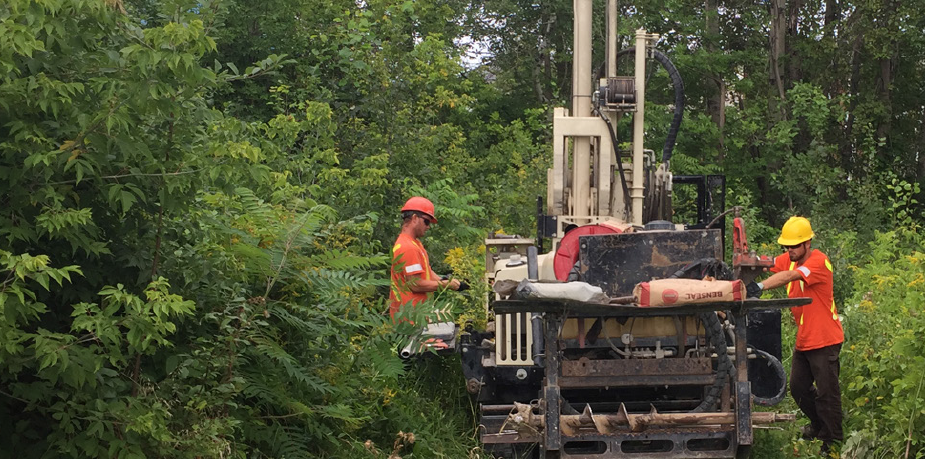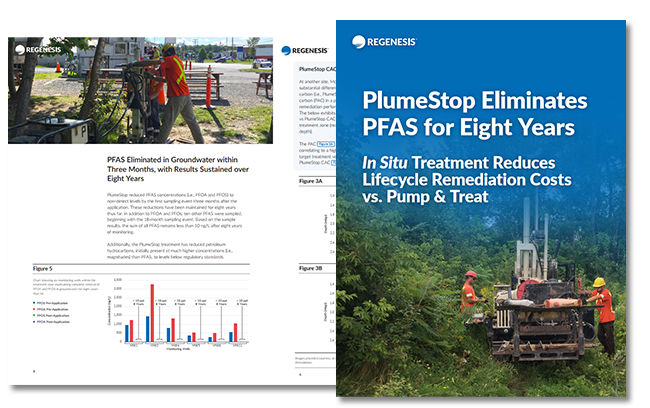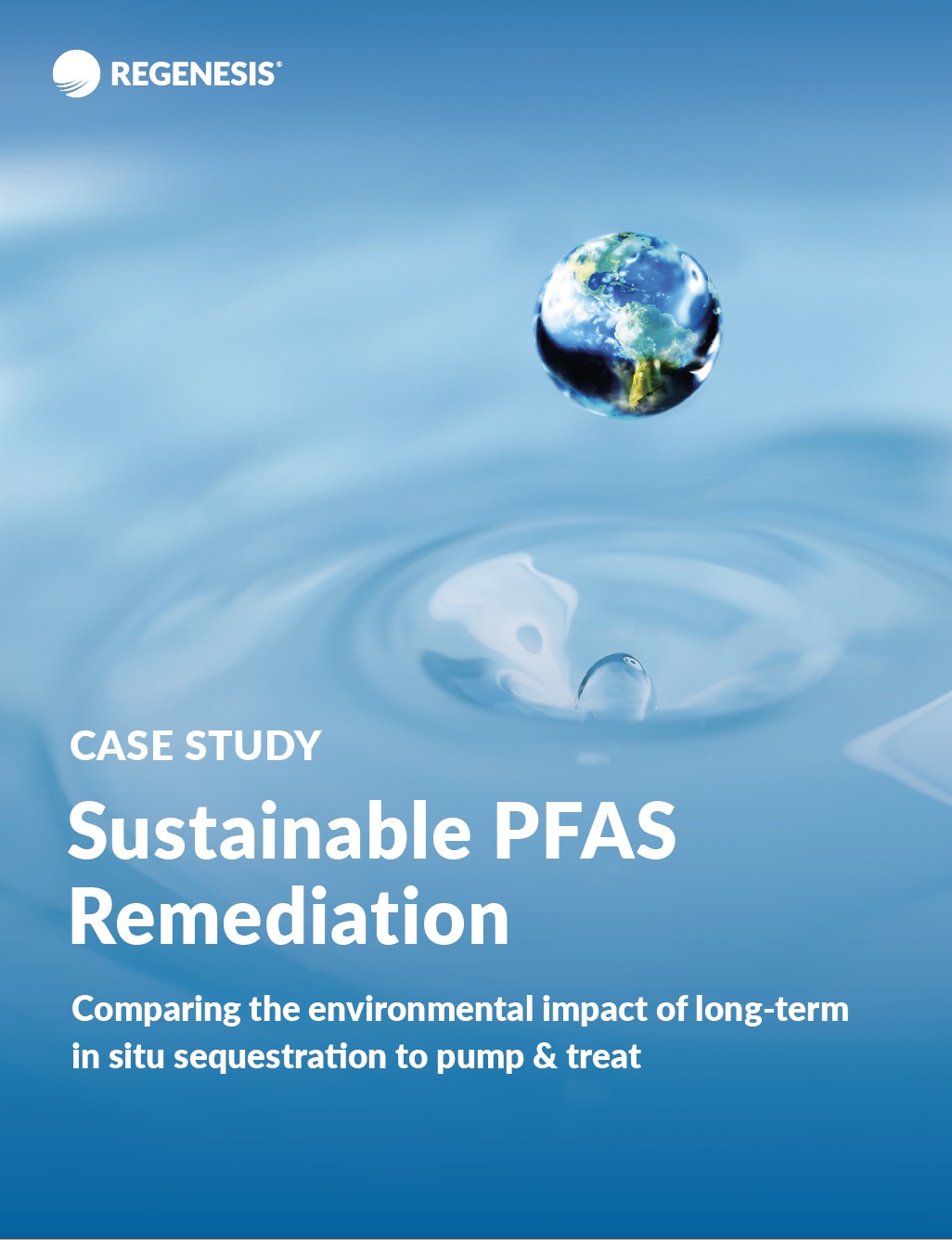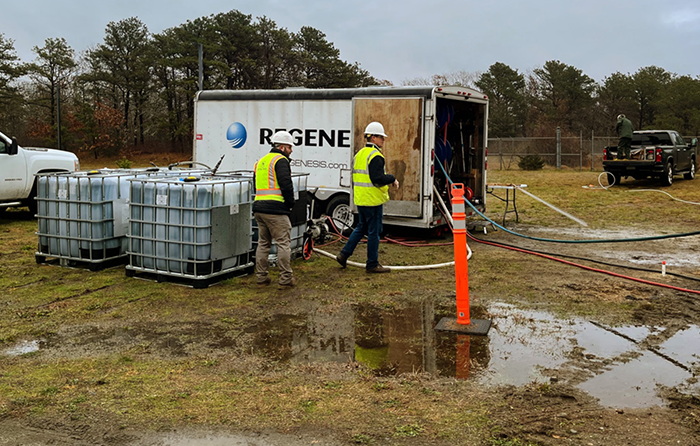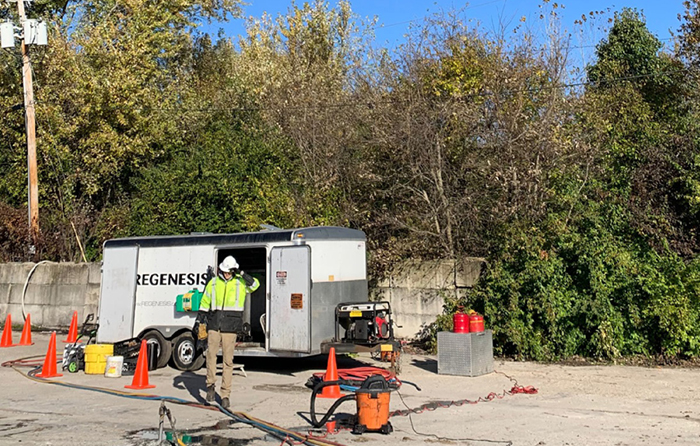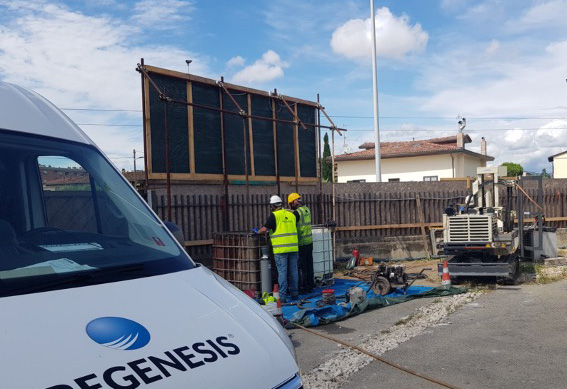PlumeStop Eliminates PFAS for 8 Years
This case study reviews the first known full-scale in situ PFAS treatment worldwide completed in 2016 at a manufacturing and former firefighting training site in Ontario, Canada, where aqueous film-forming foams (AFFF) were used.
A single application of PlumeStop resulted in a significant reduction of contaminant concentrations to below standards for 8+ years since the injection.
Case Study Highlights
- PlumeStop application reduces PFAS to non-detect within 3 months, maintaining for 8+ years thus far
- Remediation company IRSL collects critical treatment zone information to ensure successful application
- Sampling confirms PlumeStop fully distributed through the treatment zone
- Third-party modeling indicates that PlumeStop will halt PFAS migration out of the treatment zone for more than 60 years
Sustainable PFAS Remediation: Comparing the environmental impact of long-term in situ sequestration to pump & treat
This case study gives an overview of the findings of a sustainability comparison study carried out by Ramboll where REGENESIS in situ sequestration approach with PlumeStop® has been compared to ex situ treatment of PFAS contamination using Pump & Treat with GAC and Pump & Treat with Foam Fractionation.
Treatment Solution for Large TCE Plume Saves Client $380,000
Case study highlights
At a former manufacturing facility high levels of chlorinated solvents had been released into the groundwater, creating a large plume extending to the nearby river. A combined in situ biogeochemical reduction solution rapidly mitigated the threat to river:
-
Large TCE plume effectively treated using combined technology solution from REGENESIS, including PlumeStop® and S-MicroZVI®
-
Accurate mapping of CVOC flux zones using FluxTracers® saves millions in project cost
-
Safe and efficient installation meets time and budget requirements
6m 38s reading time
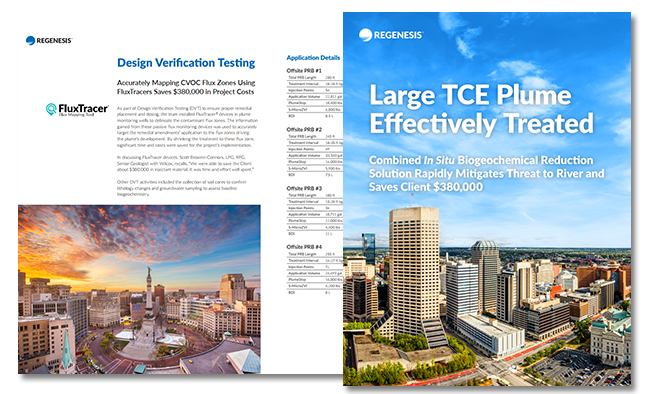
Combined Remedy Rapidly Achieves Targets to Address Chlorinated Solvent Impacts
Case study highlights
-
A multi‑faceted remedial solution mitigates CVOC contamination beneath an active business
-
Successful application overcomes challenging site conditions
-
Groundwater effectively treated using PlumeStop® and
S-MicroZVI®, expediting site closure
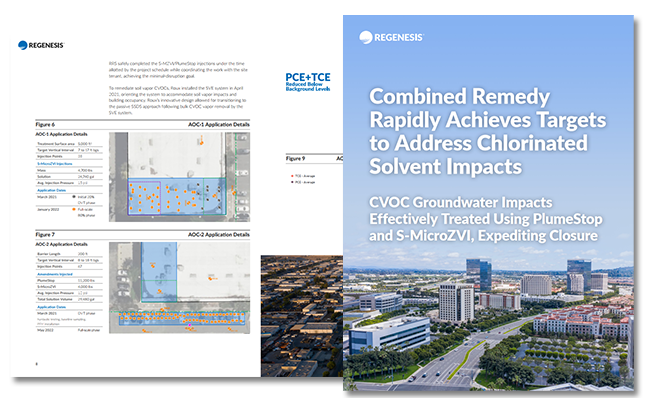
Martha’s Vineyard Airport Successfully Treated Using PlumeStop to Eliminate PFAS Risk
This case study reviews a site at Martha’s Vineyard Airport where a PlumeStop barrier was used to treat PFAS. In less than four months, PlumeStop has eliminated PFAS mass flux immediately downgradient of the barrier and significantly reduced PFAS concentrations further away, as monitoring continues. The cost-effective and sustainable solution to remove PFAS exposure risk provides an alternative to expensive and ineffective pump & treat (P&T) systems.
Tetra Tech, a global environmental consulting firm, has worked with Martha’s Vineyard Airport over the years, addressing a dry-cleaning solvent release and other environmental issues at the site. At the request of the airport, Tetra Tech conducted an initial, preemptive PFAS assessment in 2018, confirming the presence of PFAS, commonly known as “forever chemicals” in groundwater. The remediation goal was to stop further PFAS movement away from the site. Tetra Tech opted for an in situ remediation approach. A PlumeStop injected permeable reactive barrier (PRB) was installed to passively filter PFAS out of groundwater, sorbing the contaminants onto the aquifer matrix and preventing further plume migration.
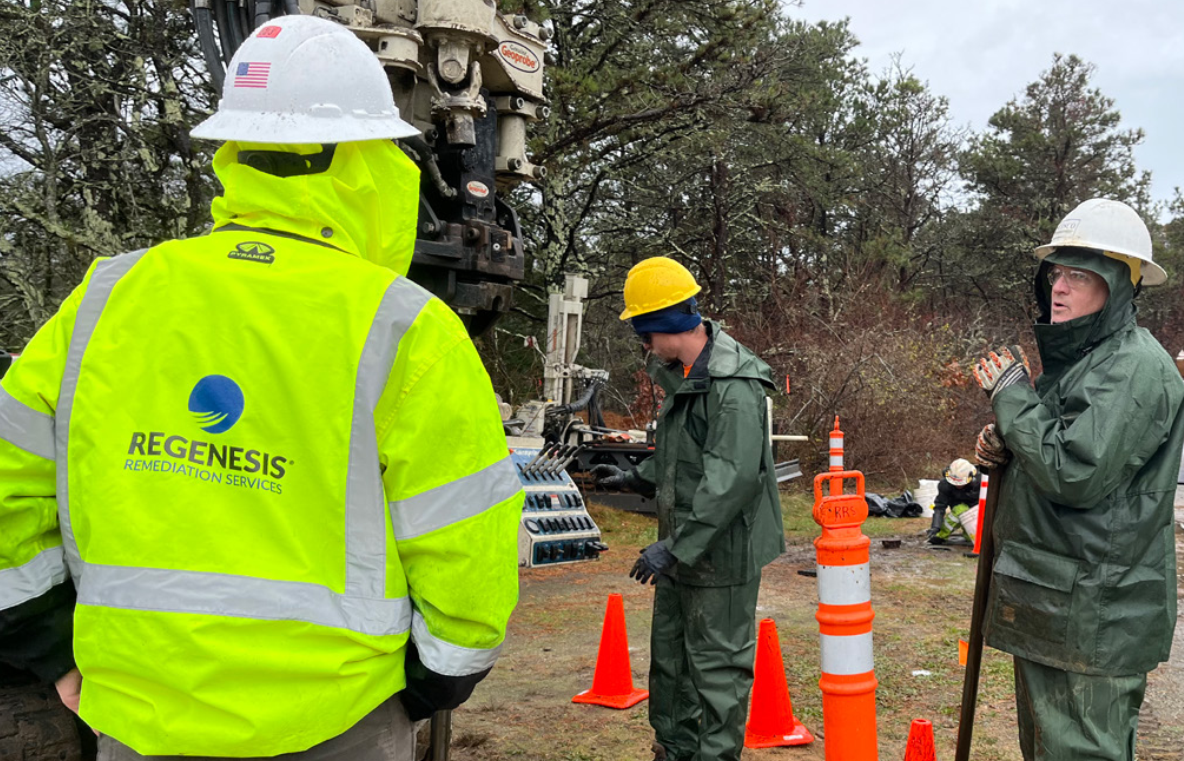
Case study highlights:
- Cost-effective in situ approach addresses PFAS risk, with no greenhouse gases or hazardous waste produced
- Contaminant flux measurements were obtained using FluxTracer, informing the PlumeStop dose required in the barrier to achieve the treatment objective
- Early performance data show PFAS mass flux eliminated downgradient of PlumeStop barrier, as monitoring continues
7m 16s reading time
Achieving site closure for a large PCE plume in urban area
This case study reviews a former dry cleaner site in a town in Indiana, USA, where site regulatory closure was achieved after a large dissolved-phase PCE groundwater plume was successfully treated using PlumeStop, enhanced reductive dechlorination (ERD) amendments and S-MicroZVI from REGENESIS. Patriot Engineering, a leading environmental consulting firm, specified ERD as the most practical and economically viable method to effectively treat the large plume.
Patriot’s strategy to achieve closure was to significantly reduce the PCE plume and then to demonstrate plume stability through post-remediation monitoring. By combining remediation technologies from REGENESIS with a highly efficient and cost-effective remediation design, Patriot’s treatment approach eliminated the PCE plume. Subsequent performance monitoring and analysis completed by Patriot demonstrated plume stability, earning the site a No Further Action status from the state regulator.

Case study highlights:
- Closure achieved for a large chlorinated solvent plume in an urban area
- A challenging site: located in an urban area with access limitations
- PCE sources rapidly eliminated and plume efficiently treated using a suite of REGENESIS in situ remediation technologies
11m 14s reading time
Reductive Dechlorination Approach Treats Large Chlorinated Solvent Plume
Case study highlights:
- Innovative combined remedy on active site effectively eliminates risk to adjacent property
- Remedy from REGENESIS chosen based on proven effectiveness in treating similar large CVOC plumes
- Design Verification Testing and placement validation guide a successful remedial application
This case study reviews the successful in-situ treatment of chlorinated solvents at a former food processing plant located in a suburb south of Indianapolis. PlumeStop, S-MicroZVI, 3DME and BDI Plus were used in combination to strongly inhibit CVOC plume migration near the site property boundary while enhancing abiotic and biotic degradation of CVOCs at this location and in the upgradient plume area. Patriot Engineering and Environmental, Inc. (Patriot), a leading consulting firm based in Indianapolis, investigated the site, discovering contaminants had migrated from an unidentified source and formed a large plume. In addition, it was found that the plume was being pulled toward a former (now inactive) public water supply well. The primary chlorinated volatile organic compounds (CVOCs) detected in the plume were tetrachloroethene (PCE), trichloroethene (TCE), and cis-1,2-dichloroethene (cis-DCE).
Injectable PRB provides rapid remediation of chlorinated plume allowing redevelopment within months
Stringent regulatory targets achieved in short timescale, despite challenging site conditions
Historical industrial activities at a former silver frames manufacturing facility in Central Italy had caused chlorinated solvent contamination in the subsurface, which was extending beyond the site boundary. As the site was undergoing redevelopment into residential buildings, the construction company had a strict deadline for remediation to be completed and so a strategy was needed to avoid the long-term installation of active pumping equipment onsite.
Highlights:
- An in situ permeable reactive barrier (iPRB) was installed combining PlumeStop, S-MicroZVI and BDI Plus reagents
- Additional Design Verification Testing (DVT) was completed by REGENESIS prior to full-scale works
- Remediation targets and the client’s economic requirements were achieved on time and within budget, under a guaranteed contract
4m 44s reading time
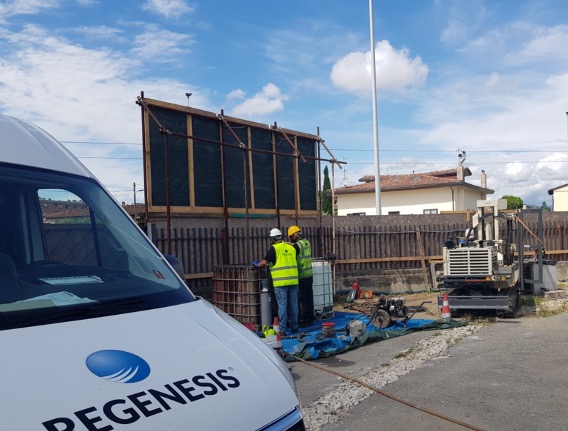
“REGENESIS has been supportive throughout all the steps, starting before our remediation design with the remedial investigation activities. Their input was crucial to identify how to best design the treatment and resulted in a very straightforward project for my client, meeting goals in a timely manner, without any surprises.”
Alessandro Lucchesini, Technical Manager, CECAM
a.lucchesini@cecamsrl.it | +39 335 835 05588
Combined ISCR and ERD remedial approach knocks down PCE concentrations in Poland
Rapid groundwater treatment achieved at manufacturing plant, without daughter product build-up
At an active manufacturing plant in the region of Greater Poland, in the West of the country, historical perchloroethylene (PCE) contamination was found to be impacting both soil and groundwater. Environmental company PROTE determined that contamination originated from a number of spills and leakages that occurred over the >20 years of manufacturing on the site
The canal adjacent to the site was identified as a potential downgradient receptor vulnerable to impact from offsite advection of the contamination. Therefore remediation was driven by a requirement to remove the site owner’s potential liability, whilst being completed within strict budgetary restrictions.
Highlights:
- Safe and easy co-injection of PlumeStop and S-MicroZVI
- A grid of 30 injection wells was used, with a 4m spacing between wells
- A rapid, significant drop in PCE concentrations was achieved in the entire treatment area, with no daughter products observed
- Monitoring is ongoing
2m 4s reading time
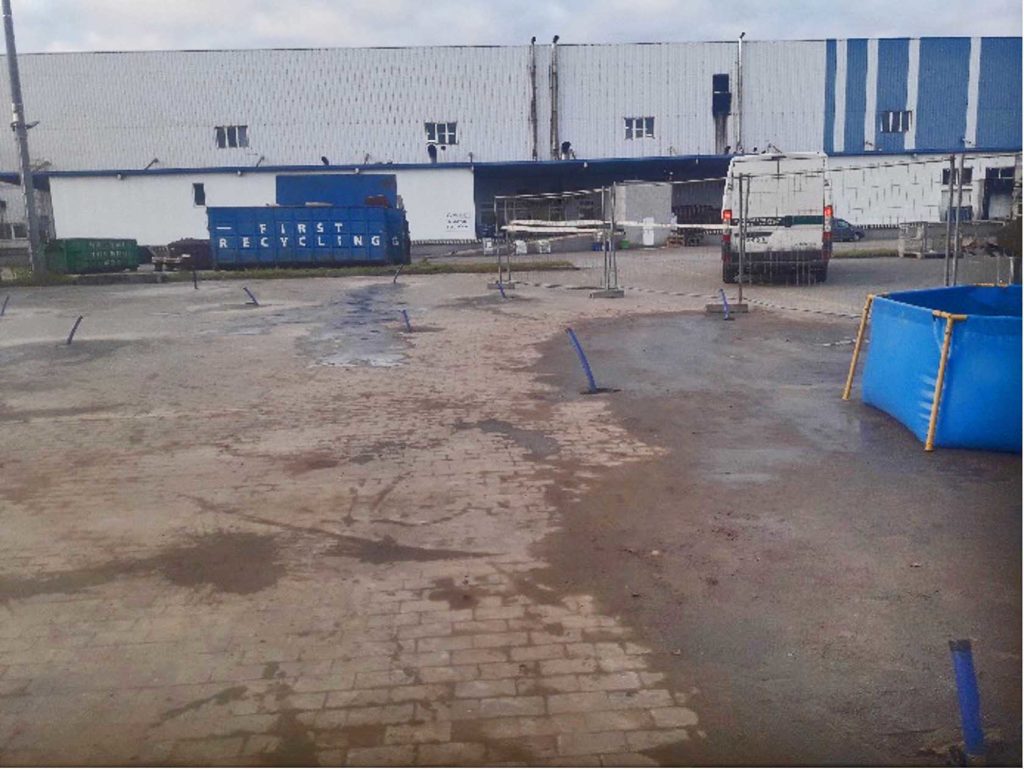
“The collaboration with REGENESIS, both during the design phase and the operational phase of the remediation works, has enabled us to apply cutting-edge technologies that reached the remediation objectives in a short period of time, whilst respecting the surrounding environment and minimising impacts on the commercial activities on the site.”
Michal Tatera, Kierownik Projektu ds. Ochrony Środowiska, PROTE Technologie dla Środowiska Sp. z o.o.
Two UK airport projects demonstrate successful in situ PFAS remediation
PFAS plumes treated with colloidal activated carbon barriers unlock regulatory permission for full-scale remedial works
We were contacted by two separate consultants working at a private and an international Airport in the UK. The groundwater at both sites was contaminated with PFAS.
REGENESIS and the environmental consultancies worked closely with the airport managers and separate regulatory authorities to ensure that two successful pilot trials were delivered demonstrating the efficacy of PlumeStop® Colloidal Activated Carbon (CAC) in preventing the advection of PFAS contamination in groundwater.
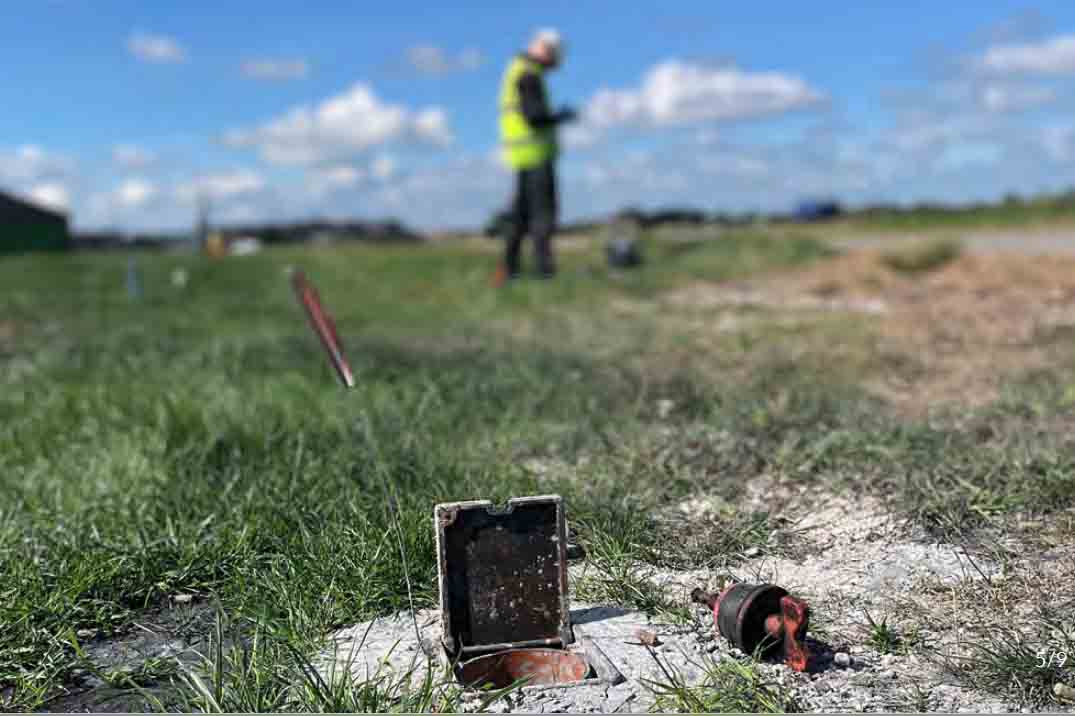
Case Study Highlights
-
For both sites, REGENESIS undertook Design Verification Testing (DVT) before installing 10m long pilot-scale barriers
-
The target compounds PFOS and PFOA were reduced to at, or close to, detection limits. The total PFAS concentrations were also significantly reduced.
-
The regulatory authorities granted permission for the progression of full-scale works on both sites
-
UPDATE : The full-scale works have now been completed at both sites and monitoring is ongoing
3m 45s reading time

 Americas
Americas Europe
Europe Français
Français Deutsch
Deutsch Italiano
Italiano Español
Español